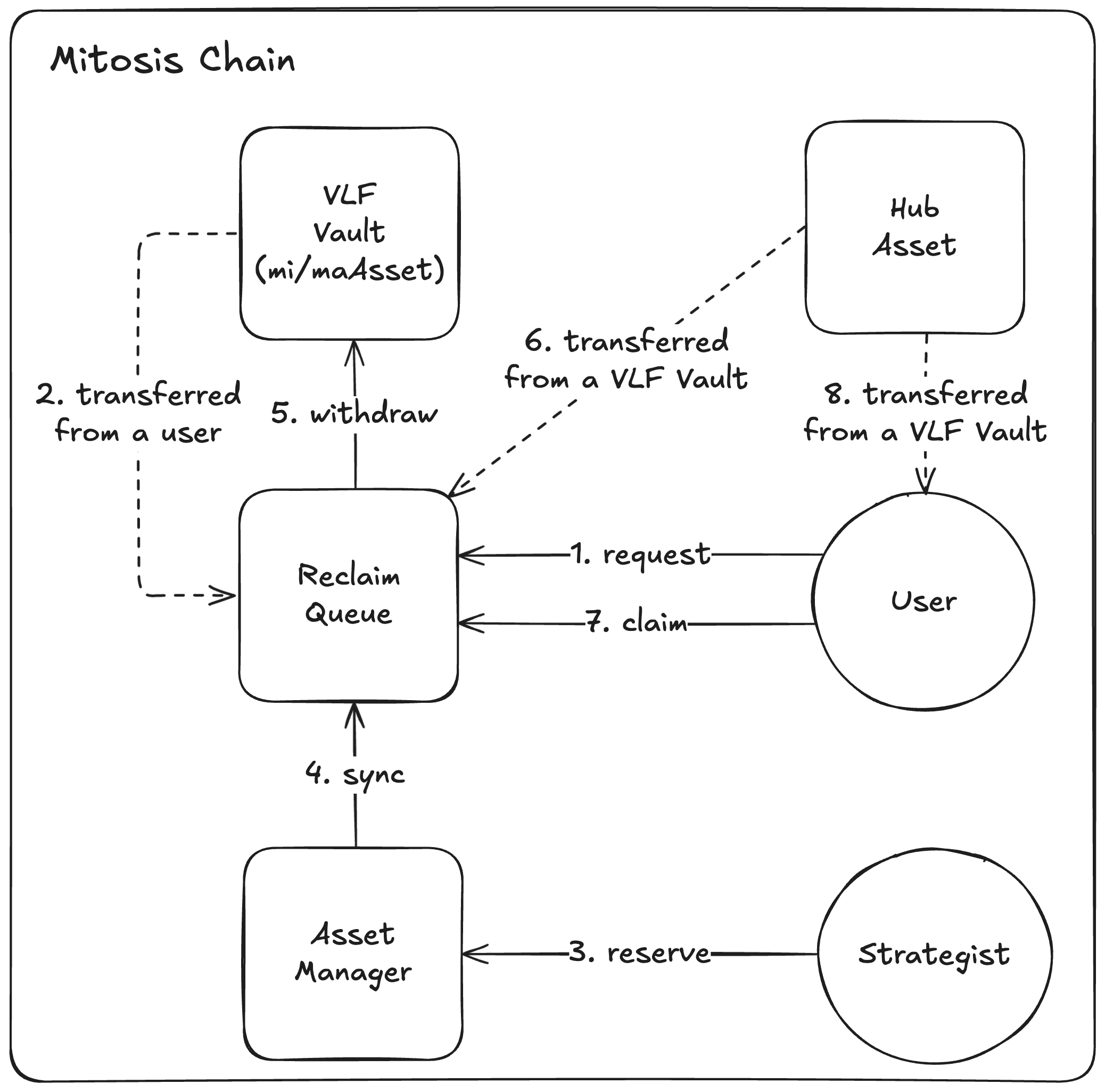Vault Liquidity Frameworks
VLF Vaults
Detailed guide to VLF Vaults and how the supply and reclaim processes work
VLF Vaults represent claims on the underlying assets (principal) and the generated yields (interest) from the liquidity opportunities using different VLF structures.
 Users can participate in liquidity opportunities by supplying hub assets to VLF Vaults:
Users can participate in liquidity opportunities by supplying hub assets to VLF Vaults:
 Unlike supply, the reclaim (redemption) process is not immediate and involves three main stages managed by the ReclaimQueue contract:
Unlike supply, the reclaim (redemption) process is not immediate and involves three main stages managed by the ReclaimQueue contract:
Key Characteristics
- Campaign-Specific: Each VLF Vault represents a specific liquidity opportunity for a specific hub asset
- ERC-20 Standard: VLF Vaults adhere to the ERC-20 standard for seamless integration
- ERC-4626 Interface: Implements ERC-4626 interface for standardized vault interactions
- Yield Generation: Designed to generate yield through strategic DeFi protocol integrations
- Deposit Caps: Implements configurable deposit limits to manage risk, ensure controlled growth, and maintain strategy efficiency
VLF Asset Properties
VLF Assets such as mi/maAssets (tokens representing shares in VLF Vaults) have the following properties:- Yield-Bearing: Automatically accrue yield from underlying strategies
- Reclaimable: Can be reclaimed for underlying hub assets through the reclaim process
- Composable: Can be used in other DeFi protocols
- Capped Supply: Subject to deposit limits that prevent excessive vault growth
Supply Process
 Users can participate in liquidity opportunities by supplying hub assets to VLF Vaults:
Users can participate in liquidity opportunities by supplying hub assets to VLF Vaults:
1
Check Deposit Limits
Verify current deposit limits using
vault.maxDeposit(userAddress) and vault.maxMint(userAddress) before attempting to supply assets2
Supply Hub Assets
Hub assets are transferred from user to VLF Vault
3
VLF Asset Minting
Corresponding amount of VLF assets are minted to the user
4
Strategy Allocation
Supplied hub assets become available for strategist to deploy in yield-generating strategies
Cap Changes: Deposit caps may change based on strategy performance and market conditions.
Reclaim Process
 Unlike supply, the reclaim (redemption) process is not immediate and involves three main stages managed by the ReclaimQueue contract:
Unlike supply, the reclaim (redemption) process is not immediate and involves three main stages managed by the ReclaimQueue contract:
Stage 1: Reclaim Initiation
1
Reclaim Request
User initiates reclaim process with a specific VLF Vault
2
VLF Asset Transfer
User’s requested amount of VLF assets are transferred to Reclaim Queue
3
Queue Position
User’s request is placed in the reclaim queue for processing
Stage 2: Request Resolution
The reclaim request is resolved when both conditions are met:Liquidity Reservation
Sufficient underlying hub assets must be reserved for reclaim (not allocated to VLF strategies)
Waiting Period
Minimum waiting period (e.g., 7 days) must elapse for security
Liquidity Reservation Process
- Strategist Assessment: Strategist checks for idle hub assets not currently in use for VLF
- Reservation: If available, strategist reserves idle liquidity for reclaim
- Withdrawal from VLF: Reserved liquidity is withdrawn from VLF Vault and moved to Reclaim Queue, with corresponding VLF assets burned
- Allocation Lock: Reserved liquidity is no longer available for VLF strategies
Stage 3: Claim Execution
1
Resolution Check
Verify that request is resolved (liquidity reserved + waiting period complete)
2
Asset Claim
User claims against their resolved request to receive hub assets back
Why Delayed Reclaim?
The multi-stage reclaim process provides several benefits:Strategy Stability
Prevents sudden liquidity withdrawals that could disrupt active strategies
Yield Optimization
Allows strategies to plan for liquidity needs and optimize yield generation
Risk Management
Provides time for risk assessment and proper strategy unwinding
Abuse Prevention
Prevents yield cherry-picking by blocking immediate supply-and-reclaim behavior

